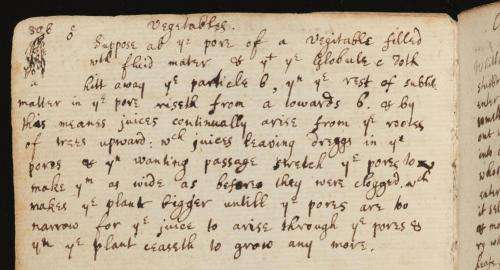February 3, 2015 report
Early Newton notebook shows prescient understanding of water ascension in plants

(Phys.org)—A new review of a notebook filled with scrawlings by Isaac Newton shows that he very nearly uncovered the secret of how plants defy gravity by pulling water up from roots all the way into their stems and leaves. David Beerling with the Department of Animal and Plant Sciences, at the University of Sheffield, in the U.K. has published a Comment piece in the journal Nature Plants describing the words written by the great philosopher and scientist in an old notebook.
Isaac Newton, was of course, one of the great minds of the modern era—his work with gravity, and the development of formulas that describe the universe, calculus and ideas on light were remarkable, doubly so considering he was a man living in the seventeenth century. Now it appears his mind at times drifted to other topics as well—such as botany. As Beerling notes, Newton kept a notebook during his college years which he used for jotting down ideas and musings. One of those was apparently an idea to help explain how it is that plants are able to pull water from the ground via roots and transport it up through stalks and stems to their leaves—defying gravity in the process.
In his notebook, Newton suggested that light pulled water particles from pores in plant leaves—as "juices" beneath flowed in naturally to refill the pore, juices from below were pulled upward. This idea is not far from what is the commonly excepted explanation for plant transpiration today—where water is pulled up a plant from roots and evaporates out of leaves, causing tension due to unequal pressure. That tension is equalized as more water is brought in from the roots. The current theory came about by botanists working in 1885, approximately two hundred years after Newton was writing in his notebook.
Perhaps even more intriguing is that pores in plant leaves had not been observed yet, the microscope was still under development. Beerling suggests that Newton was actually describing tissue that was known to conduct water at the time, though he also notes that just a few years later Newton put together the first known reflecting telescope—thus it is not a stretch to consider the possibility that he built a microscope as well.
More information: Newton and the ascent of water in plants, Nature Plants 1, Article number: 15005 (2015) DOI: 10.1038/nplants.2015.5
Abstract
Buried in a notebook from his undergraduate days lie Newton's musings on the movement of sap in trees. Viewed in conjunction with our modern understanding of plant hydrodynamics, his speculations seem prescient.
© 2015 Phys.org


















